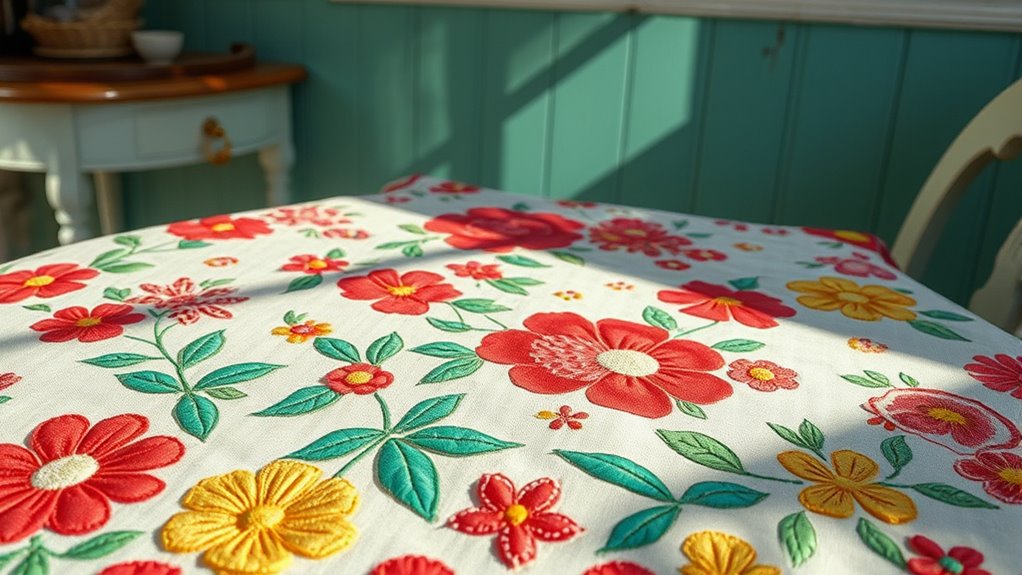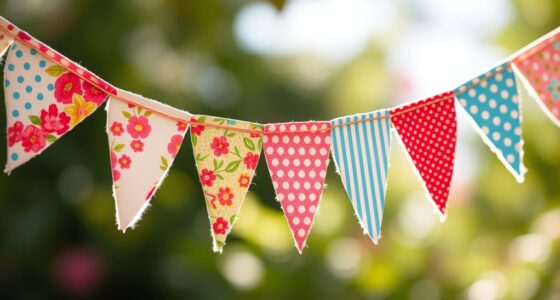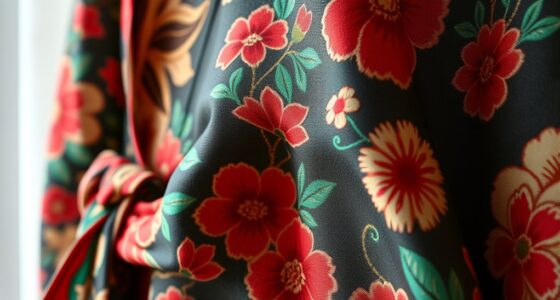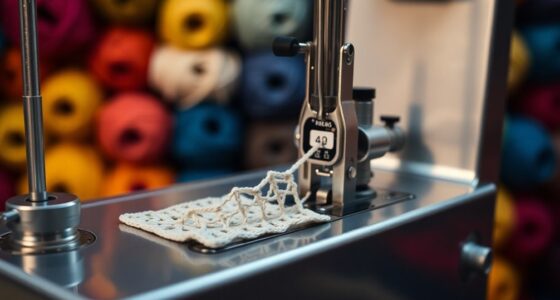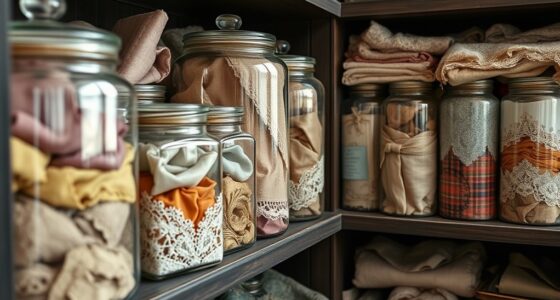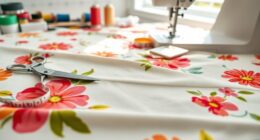To revive stained tablecloths, try creative appliqué by adding fabric patches to cover blemishes and stains. Choose sturdy fabrics that blend or contrast with your base, and secure them with decorative stitches like satin or zigzag. Enhance your design with dyeing or embroidery for extra flair. This technique transforms worn-out linens into personalized decor pieces, celebrating craftsmanship. Keep exploring to discover more tips on turning your stained fabrics into beautiful, lasting works of art.
Key Takeaways
- Use appliqué patches to cover stains and blemishes, transforming worn tablecloths into attractive, personalized pieces.
- Select sturdy, complementary fabric scraps and prepare them through dyeing or trimming for seamless integration.
- Attach patches securely with decorative stitches like satin or zigzag to enhance durability and aesthetic appeal.
- Incorporate dyeing techniques such as dip-dye or color blending to add visual interest and unify the design.
- Finalize with embroidery or embellishments to create unique, handcrafted tablecloths that extend their lifespan and charm.
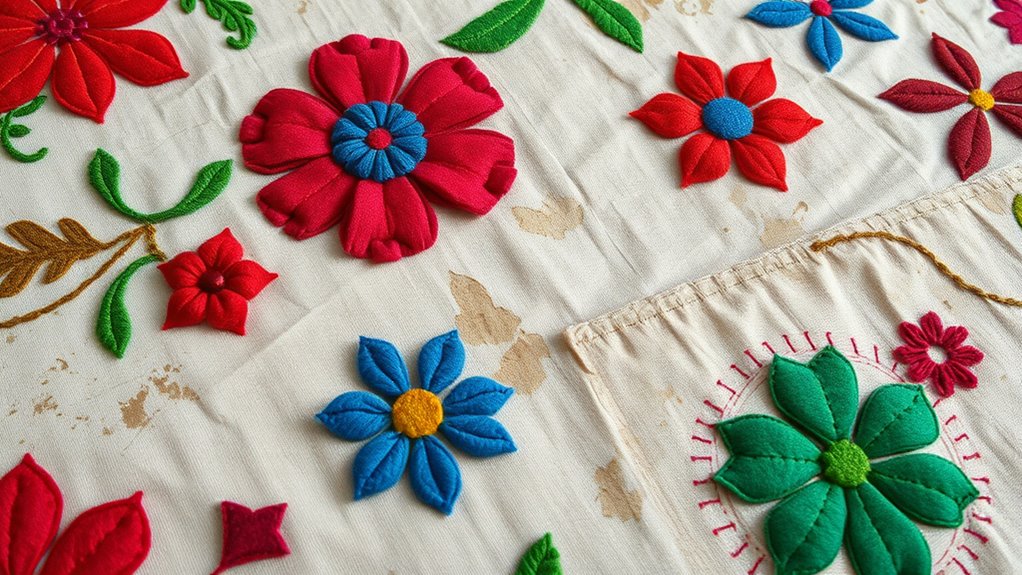
Stained tablecloths can feel like a lost cause, but with the right techniques, you can restore their beauty and extend their lifespan. One creative way to breathe new life into a stained or faded fabric is through appliqué, which allows you to cover blemishes while adding a personalized touch. Instead of discarding a worn-out piece, you can transform it into a unique centerpiece for your table, showcasing your craftsmanship and style.
Start by selecting fabric scraps that complement or contrast with your tablecloth’s base color. These pieces will serve as your appliqué patches, so choose sturdy fabrics that can withstand washing. Before attaching them, consider using fabric dyeing techniques to tint or deepen the patches, ensuring they blend seamlessly or stand out as intended. Fabric dyeing offers endless possibilities, from subtle color shifts to bold hues, allowing you to match or accentuate your existing design. It’s a simple way to refresh the overall look and cover stubborn stains effectively.
Once your patches are ready, use embroidery techniques to secure them in place and add decorative detail. Simple stitches like satin stitch or zigzag can firmly attach appliqué pieces, while decorative embroidery stitches can create a border or pattern around the patches, giving your tablecloth a polished, handcrafted appearance. Embroidery not only strengthens the appliqué but also adds an artistic element that elevates the entire piece. With a variety of stitches at your disposal, you can customize the design to reflect your personality or theme, turning a stained cloth into a work of art.
As you work, consider incorporating fabric dyeing techniques on the appliqué patches or the surrounding area to create color harmony or contrast. For example, dip-dyeing the patches can give them a gradient effect, making the appliqué stand out even more. Combining fabric dyeing with embroidery techniques makes your design more dynamic and visually appealing. Plus, these methods allow you to creatively cover up stains or discoloration without sacrificing the fabric’s integrity. Additionally, understanding the importance of color accuracy in your dyeing and embroidery choices can help achieve more professional and cohesive results.
In the end, applying appliqué with fabric dyeing and embroidery techniques transforms your stained tablecloth into a fresh, customized piece. It’s an eco-friendly, cost-effective approach that celebrates your creativity while extending the life of your textiles. With patience and imagination, you’ll turn a faded or stained tablecloth into a cherished, one-of-a-kind masterpiece that adds warmth and personality to your home.
Frequently Asked Questions
Can Appliqué Hide Permanent Stains Effectively?
You wonder if appliqué can hide permanent stains effectively. While it offers excellent decorative concealment, it may not fully cover deep or set-in stains. Appliqué provides stain coverage by strategically placing fabric patches, making the stains less noticeable. However, for stubborn, permanent marks, some staining might still show around the edges. Overall, appliqué enhances your tablecloth’s appearance and conceals stains creatively, but it’s not a guaranteed fix for all stain types.
What Fabric Types Are Best for Appliqué on Tablecloths?
Choosing the right fabric for appliqué on tablecloths is essential, and your options can feel endless—like finding a needle in a haystack! Opt for sturdy fabrics like cotton or linen because they offer excellent durability considerations and hold appliqué well. These fabrics are easy to work with, wash beautifully, and resist wear and tear. Steer clear of delicate silks or polyester, which may not withstand frequent use and washing.
How Long Does Appliqué Typically Last Through Washes?
Appliqué can last through multiple washes if you consider durability and follow washing tips. Typically, well-stitched appliqué stays intact for about 20-50 washes, depending on fabric and adhesive quality. To guarantee longevity, use gentle cycles, cold water, and mild detergents. Avoid harsh scrubbing or high heat, as these can cause the appliqué to peel or fade. Proper care helps your creative appliqué stay vibrant and durable over time.
Are There Eco-Friendly or Non-Toxic Appliqué Adhesives?
Did you know that the global demand for eco-friendly adhesives increased by 25% last year? When choosing appliqué adhesives, opt for eco-friendly adhesives and non-toxic glue, especially for items used around food or children. These options are safer for the environment and your family. They also tend to be just as effective as traditional adhesives, allowing you to revive stained tablecloths confidently without harmful chemicals.
Can Appliqué Be Removed if I Change My Mind?
If you change your mind about your appliqué, it’s possible to remove it using specific appliqué removal techniques. Look for removable appliqué options or adhesives that allow easy detachment without damaging your fabric. Gently peel or use heat or solvent-based methods, depending on the adhesive type. Just remember, the success depends on the materials used, so test a small area first to avoid any fabric damage.
Conclusion
Your transformed tablecloth becomes a canvas of renewal, each stitch a heartbeat of creativity. The stains, now memories woven into vibrant appliqué, symbolize past imperfections embraced and turned into beauty. As you step back, admire your work, feel the rhythm of renewal echoing through every sewn detail. This tablecloth, once stained, now stands as a affirmation to your ingenuity—a shining symbol that with a little love and imagination, even flaws can blossom into art.
